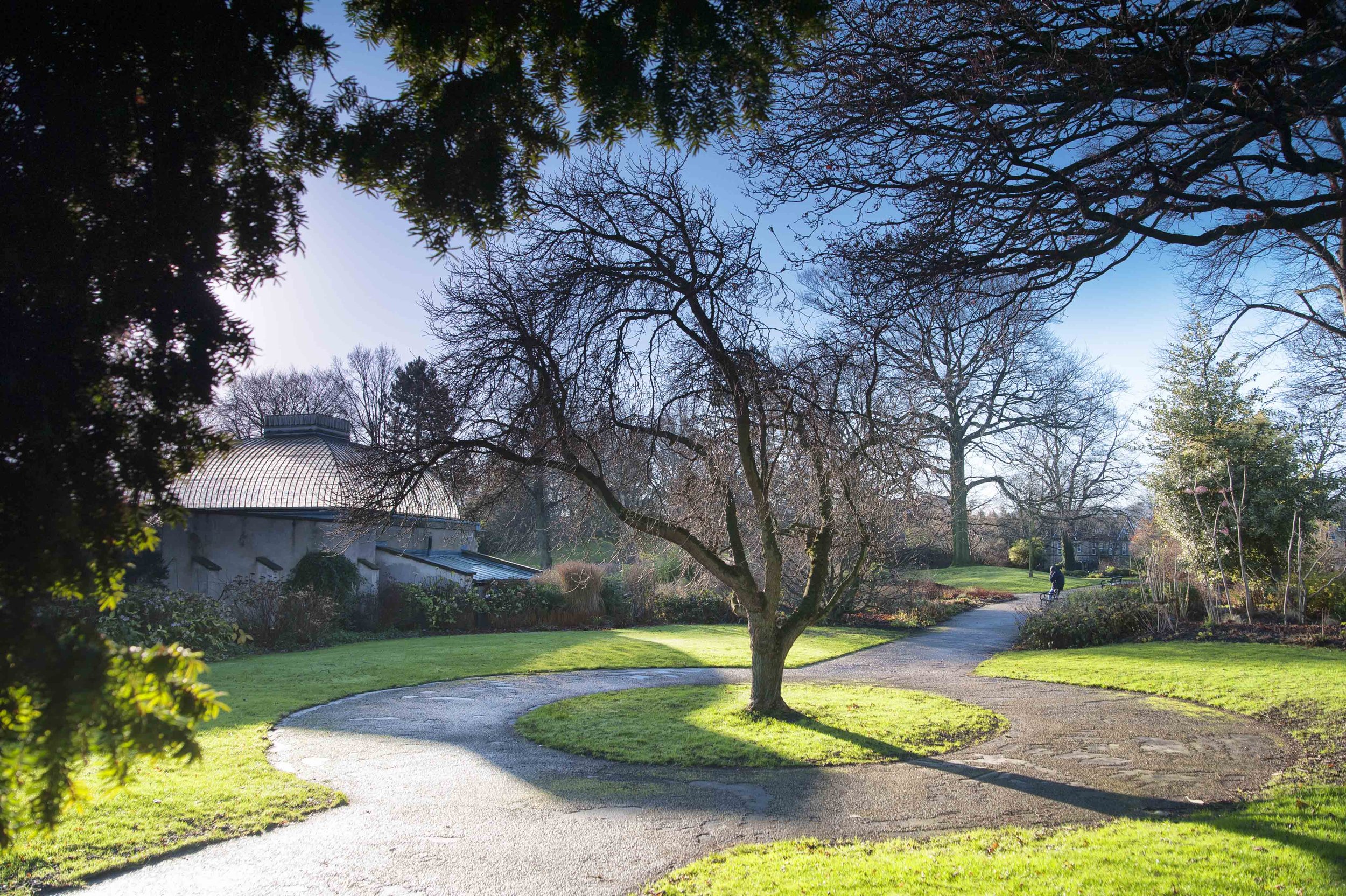Buildings and Features
There are many interesting buildings within the Gardens, some dating back to the 1830s when the Gardens were originally designed.

The Curator’s House
A Wisteria sinensis growing up the wall of the house, is beautiful in May, with fragrant mauve flowers carried in racemes.
The Jasminium nudiflorum, (nudiflorum meaning flower on bare stems) growing against the wall of the house has golden blooms which flower in mid-winter. This was a particular favourite of Robert Marnock.
Botanical Road Entrance to the Gardens - Turnstile
Located at the north-west corner of the Gardens, this wrought iron caged turnstile is Grade II listed. Prior to the Town Trust taking over in 1898, the Gardens had been totally enclosed by a high stone wall. When Clarkehouse Road was widened in about 1900, the wall was demolished and in return for the extra strip of land, the City Council provided attractive new railings. The turnstile was installed after a petition was presented to the Town Trust Committee on 12 May 1902 from 51 residents in the neighbourhood.
To the right is a fine holly, Ilex x altaclerensis ‘Balearica’. This is one of many scattered around the Gardens. Between the 18th and middle of the 20th century there was a prestigious nursery, Fisher, Son & Sibray at Handsworth, Sheffield. At its height it employed up to 200 men and boys on 150 acres. It closed in 1960 but it leaves a great legacy of the hollies in Sheffield Botanical Gardens and also the Holly Walk at Kew.
The Fountain
A four tiered fountain was depicted in Marnock’s Floricultural Magazine in 1836 but was replaced by a Crimean War Memorial, which was removed in 2003. The current fountain, made from cast iron by Dorothea Restorations, was installed in 2004.
Clarkehouse Road entrance
Here the Killarney Strawberry Tree, Arbutus unedo, thrives in the sheltered sunny corner near the shop and carries creamy white flowers at the same time as the red strawberry-like fruit in autumn.
Trees of interest
Sequoiadendron giganteum a giant redwood, also known as the Wellingtonia, and the Big Tree.
Sequoia sempervirens, a coastal redwood which grows in California, known as the tallest tree.
Metasequoia glyptostroboides, a dawn redwood, a deciduous conifer, thought to be extinct until found in China in 1941, and distributed around the world in 1948. They are grown as a street tree in Sheffield.
Ginkgo biloba Maidenhair tree which is easily recognised by its peculiar fan-shaped, undivided leaves, which turn a beautiful clear yellow before they fall in autumn. A remarkable and distinct, monotypic genus, the sole survivor of an ancient family whose ancestors occurred in many parts of the world about 160 million years ago.
Wollemia nobilis Wollemi pine. This coniferous tree was known through fossil records, but it was thought to be extinct, until it was discovered in 1994 in a remote narrow, steep-sided gorge in the temperate rainforest area of New South Wales, north west of Sydney, Australia. It became available to botanical gardens, first in Australia, and subsequently throughout the world.
Araucaria araucana the Monkey Puzzle tree. One of the few south American trees hardy in the British Isles, it was extensively planted in Victorian times. It originates from Chile, and was introduced by Archibald Menzies in 1795.
South Lodge
The lodge is an original feature of the Gardens, built to the design of Benjamin Broomhead Taylor during 1834-6. It marks the place of the former south entrance gate to the Gardens and was the home of one of the park-keepers. In Spring, the Japanese quince, Chaenomeles species ‘Moerloosei’ produces a wonderful display by the door of the Lodge.
The Bear Pit
The Grade II listed Bear Pit can be found between the Mediterranean and Himalayan gardens. It was constructed as a zoological exhibition space for the Garden and was never used for bear-baiting, which by that time was illegal. At the grand opening in 1836 it was occupied by a black bear. The Gardens also held cages of monkeys, a deer, a fox, parrots and a pair of eagles. In 1839 the attempt to combine zoological with botanical exhibits was ended because, according to a report from Loudon: ‘The filth, stench, roaring, howling and other annoyances incident to carnivorous animals, are altogether inconsistent with the repose which is essential to a botanic garden’.
The pit and adjoining quarry were then used to store lumber before being transformed into ‘a romantic little retreat, filled with evergreens’ in 1848. However, in 1855, the Bear Pit was brought back to its original use when Sir Henry Hunloke from Wingerworth Hall presented the Gardens with two brown bears. However, the shareholders denounced the bears as a ‘waste of money’ at the AGM in 1858 and the bears were put up for sale in March 1859.
A curious legend about a bear killing a child appears to have been started in 1932 by the fourth curator’s granddaughter and can only be explained as a misremembered childhood story. There is certainly no contemporary evidence of such an event.
Since then, the Bear Pit has been fully repaired and the railings replaced. In January 2005 an 8 foot tall [2.4 metres] bear, created by sculptor David Mayne, was installed. It is made of mild steel which has naturally rusted from a pale silver colour to ‘bear brown’.






